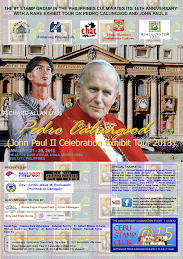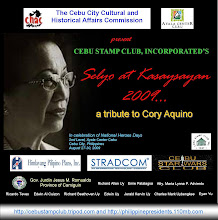The Philippine Postal Corporation (Philpost) issues a block of 4 stamp to commemorate the 100th year of St. Agnes Academy.
The 7p stamps released today, March 21, 2012 were designed by the St. Agnes Academy Centennial Committee with Victorino Z. Serevo doing the stamps' lay-out. Ma. Theresa S. Ras shared her expertise as design coordinator. The stamps were printed by Amstar Company, Inc.
Stamp # 1 highlights the artistic view of the St. Agnes Main Building façade
Stamp # 2 shows the façade of the St. Agnes Main Building World War II Ruins
Stamp # 3 features the façade of the St. Agnes Main Building in graphic rendition
Stamp # 4 sensationalizes the front view of the St. Agnes Main Building
St. Agnes Academy was founded in 1912. It was used to be known as the Academia de Sta. Ines and is the oldest Catholic School in the province of Albay, Bicol, Philippines. In 1912, Rev. Fr. Juan J. Calleja, the parish priest saw the great need of a Catholic School in Albay. He appealed with the help of Msgr. J.B. Macginley, D.D. Bishop of Diocese of Nueva Caceres before the Apostolic Delegate Msgr. Etheus.
On May 30, 1912, Srs. Ferdinanda, Alexia and Edilburgis came to Legazpi City in response to the call. This led to the birth of St. Agnes Academy on July 1, 1912 with 47 enrollees in the parish’s old parochial convent.
The Academy survived a lot of forces that threatened her existence. Strong typhoons destroyed the physical structure of the school. The 1928 Mayon Volcano eruption affected the school while World War II claimed the lives of the three pioneering Benedictine Sisters – Mother Clodesindis, Sister Edilburgis and Sr. Gertrude, an oblate. The determination of the sisters to educate the young Bicolanos succeeded and survived the turbulent years.
St. Agnes Academy grew with a stronger spirit and indomitable courage, despite the trials and difficulties that occurred. A free school was opened for the poor. In the early 1940’s, Vocational courses where incorporated with the academics. On January 1974, accreditation was granted to the Grade School Department by the Philippine Accrediting Association of Schools Colleges and Universities (PAASCU), the first in the Bicol region and the fifth in the country to be accredited. In March 1983, the High School was accredited by the PAASCU, the second school to be accredited in Legazpi City.
Bursting with new life, on that same year, the High School became co-educational, primarily, to provide a more integrated education to the young. These developments led to a gradual increase of enrollment that also saw the need to rearrangement and improve the existing facilities of the school.
Adapting with the changes of modern society, St. Agnes Academy found it necessary to become involved in a wider program of activities. The school reached out to the poor through its socio-pastoral apostolate that gave maximum service to its students and to the larger community as a whole. The Agnesian family involved themselves in a lot of activities. Ecological drives, medical and dental missions, catechetical instructions and community workshops formed part of the school’s effort to keep in touch with present day realities.
In 2006, the school encountered another challenge. While preparing for the PAASCU re-accreditation, Mayon Volcano erupted and typhoon Milenyo and Reming hit the country that damaged the school's infrastructure and all its preparation that bought it to its knees. Despite all the setbacks, the morale of the school community remained strong and the spirit of volunteerism and cooperation helped them to bounce back with a new start.
Since then, the school went on with its facilities improvement progam. They intensified and restructured its Social Involvement Program. Parish and diocesan linkages were strengthened and program thrusts and services were refined. The school's centennial celebration was launched during its school year 2011-2012 to honor a century of Catholic Benedictine in Albay.
Today, after the debris of typhoons, ashes of eruption and devastation of war, St. Agnes Academy continues to soar high and stands proud of her achievements. As another century unfolds, she continues to commit herself to the struggle for justice, peace, preservation of the environment, children and women’s rights, moral regeneration and social transformation. All these for God’s honor and glory. Dios Mabalos, Dios Mapadagos.


























